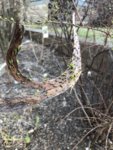It is a desirable trait in many succulents and cactus and in many plants like the Japanese Fantail Willow. The one in the picture is a Fantail Willow. Many flowers, such as celosia commonly exhibit this trait. Anyone that spends a great deal of time with plants is going to see this from time to time whether intentional or not. I have seen it many times over ther past 60 years, but generally less often than witches brooms. It is caused when the merristem cells grow in a flattened shape rather than the usual cone shape. It is a mutation that some people hate and some find fascinating.

